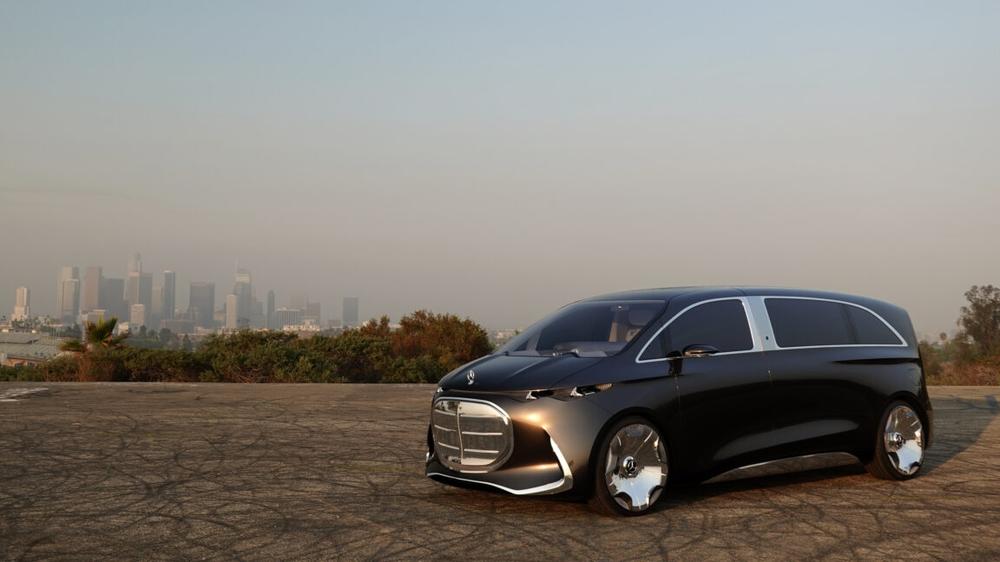An orange tint of smoke in the air always contributes to dramatic lighting for sunrise photos in Los Angeles. But this early in the fire season, the coloring serves as an inescapable reminder of greenhouse gas emissions and the mobility solutions that might reduce or at least slightly mitigate the future of radical weather crises. It's fitting, then, that a massive 75,000-acre fire burns in Santa Maria, in addition to a small brush fire on the 110 freeway less than a mile away as I visit the Elysian Park Helipad overlooking Dodger Stadium to check out Mercedes-Benz’s new Vision V concept van ahead of its American debut at Monterey Car Week.
The Vision V certainly looks like a concept car, with futuristic and swooping lines that somehow manage to make an otherwise utilitarian van shape at least somewhat stylish. Over 800 tiny light louvers spread across the grille and headlight bar at the front and the taillights at the rear, where a microscopic spoiler matches a chrome lower diffuser.
As usual with these design exercises, the Vision V sports huge wheels and low-profile tires, but a Benz rep on hand claimed that the final production design will strongly resemble this concept form. On a wheelbase of 139 inches (3,530 mm), the van measures 18 feet long by 82.7 inches wide and 74.5 inches tall (5,486×2,100×1,892 mm). Most of those dimensions will change by only fractions of inches, other than the height, which will grow about 3–4 inches taller (76–101 mm).
Still, expect short overhangs and big wheels, even if not quite the size of these absurdly chrome 24-inchers. Mercedes also confirmed vague powertrain details, including front-wheel drive and 4Matic variants—presumably single and dual-motor, though my question about a tri- or quad-motor à la the electric G-Wagen received a firm “no comment” in response. Similarly, no word on battery capacity other than a range target of 300 miles.
One detail repeated more than a couple times: rear-wheel steering. Benz wants this van to drive more like a passenger car than a utilitarian van, but short of a drive test, I spent most of my time on the smoky helipad experiencing the interplay between design and technology. “Power domes” on the hood continue through the windshield onto the long dash—intended to make this van look more dynamic—where the typical Mercedes cockpit features three massive “Superscreen” digital displays.
What’s inside?
But the front pales in comparison to the rear passenger compartment, where a 65-inch roll-up screen supports gaming, movies, and of course, video chats for taking work calls—even karaoke. Up to 42 speakers include exciters in the concepty seats, with Dolby Atmos capabilities and another seven projectors intended to create a fully immersive environment.
Those seats might look aggressive but actually provide supple support, from the upright captain’s chair to almost fully horizontal “zero gravity” modes. A chess set and beverage glasses probably matter less to most buyers than the Wi-Fi and hotspot and voice-activated MBUX infotainment, short of wasting time at charging stations anyhow.
And a solar panel roof might help reduce charge times marginally, with 168 IBC cells (interdigitated back contact) good for 539 W of charging—or an average of about 2.08 kWh per day and up to 3.44 kWh on a sunny day. The roof should therefore theoretically capture enough energy to contribute to around 13 miles of range, though in the heat of sunny days, it makes almost as much sense to think of those extra cells as contributing to climate control for the large greenhouse.
The production version of the Vision V will not bear Mercedes-Benz’s EQ nomenclature, instead pivoting to a naming structure based on the VAN.EA scalable architecture and dubbed the VLE and VLS (similar to GLE and GLS). And like the new all-electric CLA, the vans will use an 800 V electrical architecture and a NACS charge port for the USA.
Obviously, plenty of the more concept car details likely will not survive to production. The proportions may calm down and end up looking more akin to a Lucid Gravity. Smaller wheels with a different design will undoubtedly be more durable and aerodynamic. Normal enclosed head- and taillights will be more durable and aerodynamic. Will the door hinges carry over versus rolling rails that might be more durable, but less aerodynamic? Eventual pricing tiers enter the chat now, even if the chess board and art deco ceiling lights might remain as options.
But that begs the question: Are super-luxe vans with champagne chillers, 65-inch disappearing displays, and massive battery packs the answer to increasing EV adoption? Commercial vans do seem like a great use case for electric power, but this preview of the eventual luxurious VLS seems more tailored to the Asian market. A potential eight-seater people-hauler VLE also caters well to European airport transfers, but a lower-priced commercial delivery van simply needs none of the bells and whistles.
Then we need to consider whether any of the variants gain traction in the USA, where Americans seemingly forgot about minivans two decades ago and where EV adoption—indeed, any alternative to the fossil fuel industry—appears to be stalling out. Though at the very least, fleet managers typically see the EV/ICE equation more rationally than average private consumers, which may play well into Mercedes-Benz’s eventual plans for the Vision V concept.

 GTA 6 boss says devs desperate to beat “extraordinary expectations”
GTA 6 boss says devs desperate to beat “extraordinary expectations”